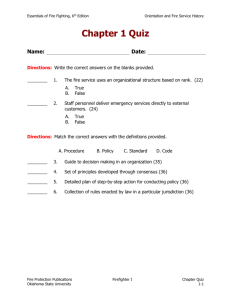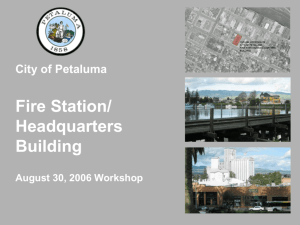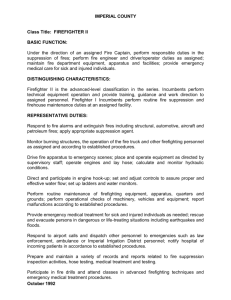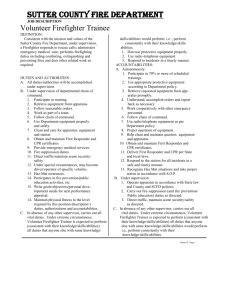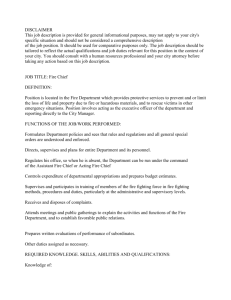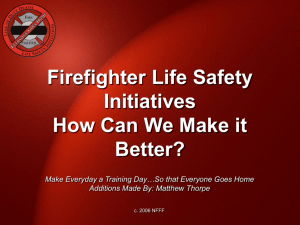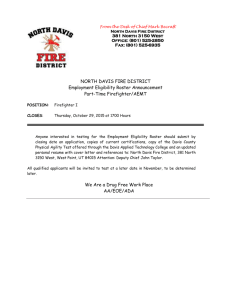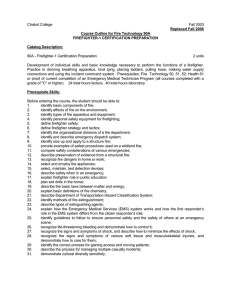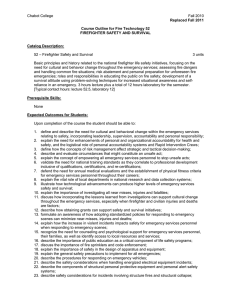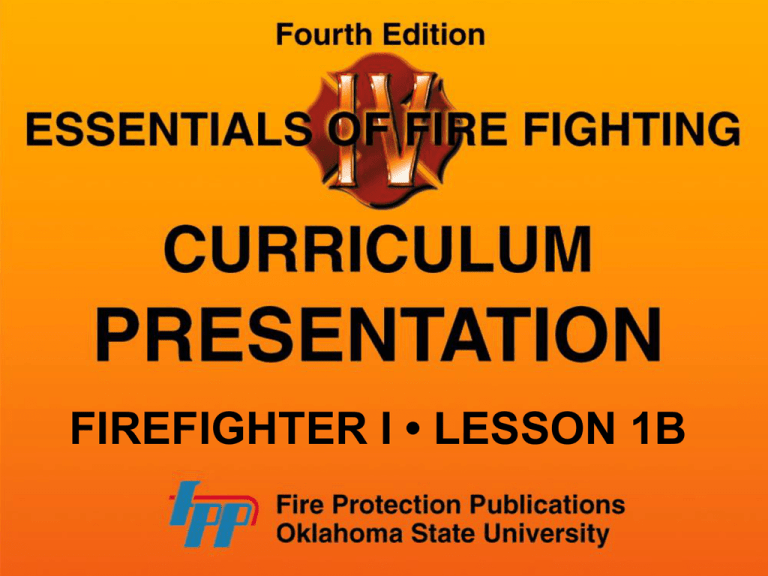
FIREFIGHTER I • LESSON 1B
TS 1B–1
GOALS OF A FIREFIGHTER
SAFETY PROGRAM
• Preventing human suffering, deaths, injuries,
and exposures to hazardous atmospheres and
contagious diseases
• Preventing damage/loss of equipment
• Reducing the incidence and severity of
accidents and hazardous exposures
Safety practices cannot simply be taught –
they must be practiced and enforced.
TS 1B–2a
FIREFIGHTER HEALTH
GUIDELINES
• Stay informed about job-related health issues.
• Follow recommendations for vaccination against
hepatitis B.
• Use precautions to avoid exposure to HIV.
• Learn proper lifting techniques.
• Use tools designed to assist in lifting heavy
objects.
• Properly clean and store tools and equipment
used in patient care.
TS 1B–2b
FIREFIGHTER HEALTH
GUIDELINES (cont.)
• Maintain a regular exercise program to sustain
physical fitness.
• Maintain a diet that reduces cholesterol, fat,
and sodium intake.
• Be aware of cardiovascular and cancer risks.
• Have regular physicals and medical check-ups.
TS 1B–3
EMPLOYEE ASSISTANCE PROGRAM
AREAS OF ASSISTANCE
• Alcohol abuse
• Divorce
• Drug abuse
• Career development
• Personal problems
• Nutrition
• Stress
• Hypertension
• Depression
• Smoking cessation
• Anxiety
• Weight control
TS 1B–4
BENEFITS OF AN EMPLOYEE
ASSISTANCE PROGRAM
• Is available to all members and their families
• Provides referrals
• Provides health education and counseling
• Assists with handling critical incident stress
Prebriefing
Debriefing (CISD)
Defusing
TS 1B–5
APPARATUS
SAFETY RULES
• Seat yourself in the
apparatus.
• Do not ride standing
anywhere on the
apparatus.
• Do not dress while
apparatus is in motion.
• Ride within fully enclosed
portion of cab; if unable,
wear helmet and eye
protection.
• Wear ear protection if
noise level exceeds 90
decibels.
• Fasten your seat belt.
• Never ride on the
tailboard.
• Use handrails when
dismounting apparatus.
• Jump clear of apparatus
that may be in contact
with electrical wires.
TS 1B–6
PERSONAL SAFETY RULES
IN THE FIRE STATION
• Use proper lifting techniques to prevent back
injury.
• Keep floors clean and free of slipping hazards.
• Watch your footing on stairs and uneven surfaces.
• Keep traffic areas free of tripping hazards.
• Be sure that aisles are unobstructed and that stairs
are well lighted.
• Maintain handrails, slide poles, and slides in a safe
condition.
TS 1B–7
TOOL & EQUIPMENT
SAFETY RULES
• Replace damaged or
broken tools.
• Return tools to storage
after use.
• Inspect and clean tools
before storing.
• Secure manufacturer’s
approval before
modifying a tool.
• Use spark-resistant
tools in flammable
atmospheres.
• Wear appropriate PPE.
• Remove all jewelry.
• Select the appropriate
tool for the job.
• Know the
manufacturer’s
instructions and follow
them.
• Inspect tools before
use to determine their
condition.
TS 1B–8
HAND & POWER TOOL
SAFETY RULES
HAND TOOLS
• Inspect all tools before each use.
• Never use a “cheater” to supply additional
leverage.
POWER TOOLS
• Ensure that trained, authorized personnel make
repairs.
• Ensure that any electrical tool not marked
“double insulated” has three-prong plug.
TS 1B–9a
POWER SAW
SAFETY RULES
• Match the saw to the task and the material to be
cut.
• Wear proper protective equipment.
• Have hoselines in place when using a power
saw to force entry into an area where fire is
suspected and when using a power saw to
perform vertical ventilation.
• Avoid the use of all saws when working in a
flammable atmosphere.
TS 1B–9b
POWER SAW
SAFETY RULES (cont.)
• Keep unprotected and unessential people out
of the work area.
• Follow manufacturer’s procedures for proper
saw operation.
• Use caution to avoid igniting gasoline vapors
when refueling a hot, gasoline-powered saw.
• Keep blades and chains well sharpened.
TS 1B–10
TRAINING SAFETY
• NFPA 1500 requires monthly training for all who
may engage in structural fire fighting.
• Other training sessions should be required as
needed or at least twice a year.
TS 1B–11
PERSONAL SAFETY
• All training at a drill site must include
protective gear.
• Trainees with any symptoms of illness should
have a medical examination before they
continue training.
• Horseplay during training is forbidden.
TS 1B–12
MAINTAINING & SERVICING
EQUIPMENT
• Training equipment must be maintained in peak
condition.
• All tools and equipment should be inspected
before each drill.
TS 1B–13
EMERGENCY SCENE SAFETY
CONSIDERATIONS
• Is it safe or feasible to undertake the emergency
operation?
• Does operation require rescuing victims or
stopping property loss?
• Do risks involved warrant limiting the actions of
firefighters?
• Remember that the IC’s first priority is firefighter
safety; the second, victim safety.
TS 1B–14
CROWD CONTROL
• Know that law enforcement is usually
responsible for crowd control.
• Keep all bystanders away from the incident for
their own safety and that of victims and
emergency personnel.
• Keep friends and relatives of victims away from
the incident but treated with sensitivity and
understanding in an area of their own.
• Know that zone boundaries are affected by
work space, hazard degree, and topography.
TS 1B–15
PERSONAL ACCOUNTABILITY
TAG SYSTEM
• A simple tag system can help account for
personnel within the fireground perimeter.
• Identification tags are attached to a control
board for quick reference.
TS 1B–16
PERSONNEL ACCOUNTABILITY
SCBA TAG SYSTEM
• An SCBA tag system provides accountability
for personnel inside a structure.
• Tags allow supervisor to record time of entry
and exit of each firefighter.
© Copyright 1998, Board of Regents, Oklahoma State University
All Rights Reserved. No part of this presentation may be reproduced
without prior written permission from the publisher.

